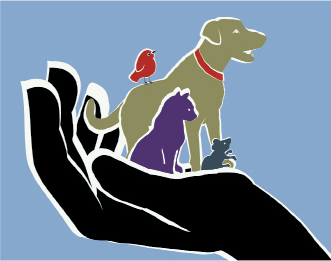
By Scott Giacoppo
From villainous depictions in films like the one found in Lady and the Tramp to the punitive-sounding "dog pound," the concept of the dog catcher has been a historically antagonistic one. Today's animal care and control services, however, are redefining the way they relate to residents and embracing principles that promote safe, humane communities for people and pets.
Because animal control services are no longer primarily concerned with rabies control, the outdated role of "dog catcher" has been replaced by the community-minded "field services liaison." Here are five reasons why:
1. We're a nation of animal lovers. According to the 2017-1018 national survey by the American Pet Products Association, 68 percent of U.S. households now own at least one pet, and annual spending on our companion animals is projected to exceed $62 billion in 2017. Dogs and cats, along with other domestic pets, are now part of the family.
Gone are the days of animal control "roundups" followed by animals being killed after their legally mandated hold periods expired. People who have pets and other community members expect humane and ethical animal care practices, which include making every effort to reunite families with lost or stray pets, and finding new homes for healthy, adoptable pets.
2. We value transparency and innovation. Thanks in part to the pervasiveness of social media, accountability and transparency from government officials—police officers, city councilmembers, animal control officers—have become major priorities for communities of all sizes. Residents want to know that their tax dollars are being spent wisely, and on programs aligned with their values.
This includes replacing outdated and ineffective animal control practices with innovative programs that keep people and pets safe, happy, and healthy. Large-scale community cat programs and efforts to end dog-breed discrimination and pursue effective, breed-neutral laws are great examples of such programs.
3. We champion proactive governance. In addition to being a nation of animal lovers, we're also a nation of problem solvers. Where once an animal control officer would be dispatched to trap and collect an animal, after which that animal would often be killed, local animal services are now focused on identifying animal-related problems and implementing long-term, cost-effective solutions.
Similar to the community policing model that champions proactive problem-solving techniques, animal care and control services are now partnering with the public and other agencies to go beyond simply reacting to complaints, and instead using data and planning to implement long-term solutions with preventative measures.
Animal control agencies across the country, including those in cities like El Paso, Texas; Boise, Idaho; Yakima, Washington; and Palm Springs, California, have embraced this proactive approach and recently completed specialized training with Best Friends Animal Society in such areas as conflict resolution and community cat programming.
4. We believe pets belong in homes, not animal shelters. Keeping pets in homes and out of shelters is at the heart of the field services liaison role. By minimizing the number of animals who enter shelters in the first place, we can make already scarce resources available to help the animals who really need them.
Animal service agencies in Santa Clara, California, and Washington, D.C., for example, have switched to issuing warnings and providing support and cost-effective resources to pet owners with violations, rather than issuing costly citations, which often result in an animal unnecessarily entering the shelter.
By providing community members with resources such as access to pet food pantries for those experiencing financial hardship and training help for those struggling with pet behavior problems, animal services are able to keep pets in their homes, reduce the costs associated with housing and killing animals, and ultimately save more pets' lives.
5. American communities are embracing the no-kill model. Today, there are more than 400 documented communities of varying sizes and demographics that are considered no-kill. These communities include major urban cities like Austin, Texas, and Salt Lake City, Utah, as well as more rural places like Boone, Iowa.
The city of Los Angeles and the entire state of Utah currently are on the verge of achieving no-kill for cats and dogs.
What It Means to Be a No-Kill Community
A no-kill community is one that acts on the belief that every healthy, adoptable dog and healthy cat should be saved. In a no-kill community, the focus is on saving as many lives as possible through pet adoption, spay/neuter, trap-neuter-return, and other community support programs, rather than achieving a specific numerical outcome.
With that said, we understand the importance of having a quantitative benchmark that communities can use as a goal. Saving 90 percent or more of the animals that enter shelters is the current benchmark for no-kill.
This means that for a community to be considered no-kill, all of its shelters and animal welfare facilities responsible for animal control intake must be saving 90 percent or more, collectively, of the animals that enter their system.
What "No-Kill" Doesn't Mean
No-kill has become an emotionally and politically charged term for many people, oftentimes because its definition is misunderstood. No-kill does not mean that:
- Shelters that haven't reached no-kill, and their employees, are willing killers.
- Dangerous or sick animals will be released into the community.
- Shelters will start warehousing animals indefinitely.
Each community is collectively responsible for its decisions regarding homeless animals and for creating safe, humane environments for the people and pets living in them. And the new field services liaison is working at the front line of the no-kill movement.
Scott Giacoppo is shelter liaison director, national programs, Best Friends Animal Society, Kanab, Utah (info@bestfriends.org). This copy was originally published as an ICMA blog, August 29, 2017, https://icma.org/blog-posts/redefining-role-dog-catcher.
New, Reduced Membership Dues
A new, reduced dues rate is available for CAOs/ACAOs, along with additional discounts for those in smaller communities, has been implemented. Learn more and be sure to join or renew today!
